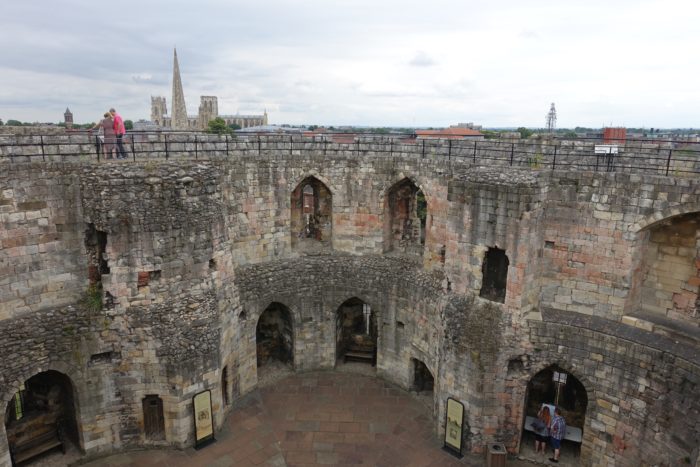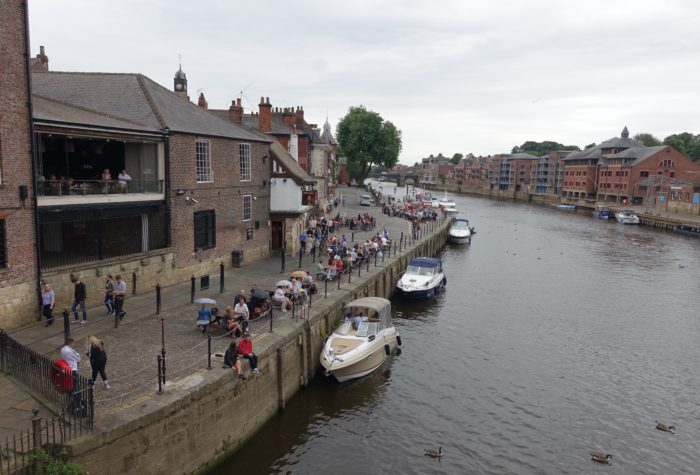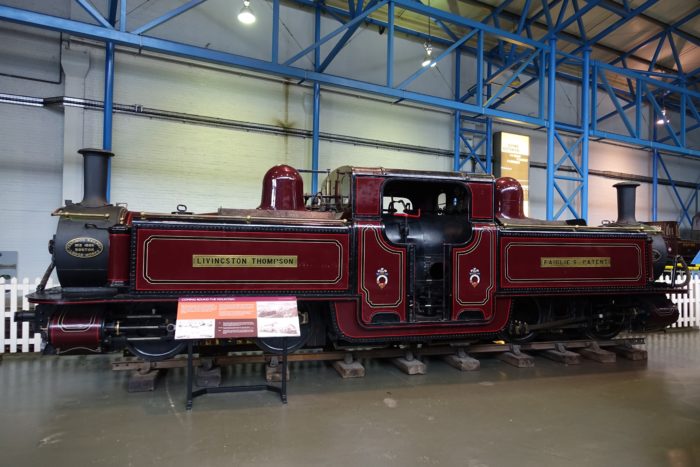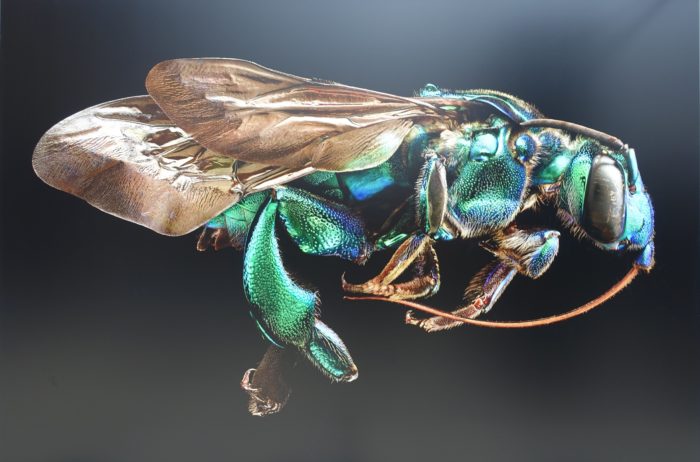GREAT BRITAIN: York & Oxford
York is one of those cities that’s just the right size with plenty of history and charm to keep things interesting. If by chance you’re feeling superficial or a little less inclined toward the cultural or intellectual there are lot’s of wonderful little shops to keep you busy. If you’ve perhaps had enough of art museums which I have had a tendency to overload the blog with, then maybe you’ll be pleased with my inclusion of the National Railway Museum in this installment. Their collection of locomotives is not to be missed. You will be mesmerized by color, line, and form since there is no escaping the exquisite designs of those steam-powered dreadnoughts of yesteryear.
YORK
My street leading the way towards the Old Town.
DOWNTOWN YORK
THE SHAMBLES – Shambles (or The Shambles as it is often referred to) is a street in the city center of York with a long and interesting past. Dating Back to Medieval times it was once the street of the Butcher Shops. Today the Shambles is Europe’s most visited street, attracting tourist, shoppers and business clients. Filled with copious charming shops, I fell prey to one even though I am already burdened with excess accumulations. I couldn’t resist a silver Greek coin depicting the Goddess Athena on one side, and a standing owl on the reverse. Add to that a Roman key, and a gift for a friend. At least the three items fit in a small box!
Cornish pasties, curios, antiques, or souvenirs anyone? By any means, go to York.
OUTDOOR CRAFT MARKET
PUNK ESCAPE ARTIST
STRANGELY DEPRESSED BACHELORETTES – This is the second encounter of this phenomenon in a few days. Bad hair, rubbish hats, and poorly fitting frocks that are not improved upon by the wobbly attempts at maneuvering in their tacky footwear.
YORKSHIRE MUSEUM GARDENS
DAME JUDI DENCH WALK
One of the strange things you might encounter along the waterway.
I’m officially old. One of my bigger thrills of the day was taking the Dame Judi Dench Walk. I’m just a sucker for walking along a lazy river under a canopy of trees.
Cute skinny boats. That reminds me, I need to get back to Amsterdam in 2018.
SURPRISE – My favorite jazz club followed me from London, and had its all-star band playing on Sunday in York! Not only that, but they’re doing a themed show of 1959: The Year That Shaped Jazz. They chose a selection of pieces from that year’s most groundbreaking discs for their performance including “Kind of Blue” by Miles Davis, “Mingus Ah Um” by Charles Mingus and “Time Out” by Dave Brubeck. Joy!
SWEET & SAVORY – Fudge and Meat Pies
MONK BAR – One of four gates into York.
WALKING THE WALLS
YORK CITY WALLS – No visit to York is complete without a stroll along part of the 2 miles of historic walls that have protected the city for nearly 2000 years.
Many pleasant vistas await. York Minstry is visible in the distance.
A tight squeeze. Can you imagine armored soldiers trying to get by one another on this thing?
Another one of York’s famous gates.
CLIFFORD’S TOWER – This is all that remains of York Castle. It’s set upon a mound which was originally built by William the Conqueror. Clifford’s Tower was built on the orders of King Henry III (1217-1272), a great builder of castles, churches and manor houses. It contained two floors linked by spiral staircases in the thickness of the walls, and though some of the internal walls and the roof have been lost, you can still see fireplaces, windows, arrow-slits and original latrines.
The plan of Clifford’s Tower is very unusual in England and closely resembles a French castle.
This Gothic Chapel contains some of the best surviving medieval architecture in Clifford’s Tower, especially the decorative arcading along the walls. The arches originally stood on thin columns which are now missing.
As you can see the second floor no longer exists in the center part of the tower.
The tower does offer some pretty good views.
NATIONAL RAILWAY MUSEUM
This one’s for my brother Buell, Chris Bacon and for anyone else whose heart races at the sight of classic locomotives. The trains are arranged in a radial layout so that they can be switched out using a pivoting track on the far end of the museum.
This is the interior of the engine compartment of the train above.
SIMPLY THE BEST – The Flying Scotsman Service was usually pulled by one of the fastest and best-looking locomotives around. This tradition started with the Stirling Singles and their elegant design. Introduced in 1870 by the Great Northern Railway, their 85mph top speed helped make the ‘Flying Scotsman’ the fastest train in the world.
Not just a train, but a work of art.
WHAT A LINEUP!
MALLARD – The fastest steam locomotive in the world. Clocked in at 126 miles per hour.
DYNAMOMETER CAR – It was the car used to record the performance of the steam locomotive Mallard during its 126mph speed record-breaking run in July 1938.
THE LITTLE WONDER – This narrow gauge locomotive caused a sensation in 1870. It could haul heavy loads around sharp turns and up steep gradients. Little Wonder pointed to a way railways could be built in mountainous areas without costly bridges and tunnels. Building a narrow gauge line also kept costs down.
PORT CARLISLE DANDY CAR – 1863 – This is one of four horse-drawn Dandy cars built by the Northern British Railway at its St. Margarets Works in Edinburgh.
DINING CAR
CAST IRON FOOTBRIDGE – 1891 – Percy Main Station – Only 50 built
Train Paraphernalia for the true aficionado.
This is a beautifully laid out museum, and the exhibits are enhanced accordingly. This is a museum that has something for everyone, and many will want to spend hours here.
VERY OLD VENDING MACHINE
It looks like a model railway, but in reality, it is a training device for the education of those wishing to learn how to become a signal person. This particular device was in service well into the sixties.
WORLD’S LONGEST RAILWAY SIGN – It’s in Welsh of course.
A model of the famous “Flying Scotsman”. Unfortunately the original was out on loan since it is a fully functional train. The good news is that this will necessitate another visit to York when it is present.
1960s BULLET TRAIN – Series N700 and N700A are the newest Shinkansen running in Japan. They are recognizable successors to this sixties model, but new technology has been utilized to create a more streamlined shape without reducing space for passengers. The nose has been designed using aerodynamics and a special elastic hood entirely covers the space between the cars reducing interior and exterior noise.
ROMAN COLUMN
CONSTANTINE THE GREATt – Proclaimed Roman Emperor in York A.D. 306.
All the Roman and Medieval armor and weaponry you could ever want.
York was Guy Fawkes home town.
Another part of York’s wall.
YORK MINSTER – Dating back to medieval times, this splendid Church of England cathedral features magnificent 14th- and 15th-century stained glass, stonework and elaborate tombs.
OXFORD
Oxford University was founded in 1167 and is the home of many fine museums which are free to the public. Former graduates include J.R.R. Tolkien, David Cameron, Michael Palin, Oscar Wilde, Tony Blair, Hugh Grant, Bill Clinton, and T. S. Eliot.
Stephen Hawking graduated Oxford in 1962.
FIRST GLIMPSE OF THE CITY
ASHMOLEAN MUSEUM
GREEK AND ROMAN STATUARY
ASSYRIAN PROTECTIVE SPIRIT – 875-860 BC
From the Palace of Nimrud in Northern Iraq, this supernatural spirit, with a human body and the head and wings of an eagle is carved in relief on a huge slab of gypsum.
Roman statue with a plaster copy in the background. The copy is embellished with vivid colors as was the practice with ancient Roman statuary. They still left the skin untouched, but most people are unaware of these adornments since the pigments in most all of the statues have long since worn off.
BRONZE PORTRAIT OF AUGUSTUS – 30-20BC – Once again we have pigment applied to the eyes as was the practice on bronze and marble busts.
DISKOBOLOS OF MYRON – 460-440 BC
SOUTH INDIA AND THE DECCAN
ANTONIO STRADIVARI – Violin “The Rode” – 1722
Pablo PICASSO – Blue Roofs, Paris – 1901
Ju MING – Taichi Arch – 2000
Henry MOORE – Three Piece Reclining Figure No. 2: Bridge Prop – 1963
CHRIST CHURCH WAR MEMORIAL GARDEN
OXFORD UNIVERSITY PARKS
SWAN & CYGNET
Meadow on the left – Canal on the right
What is the deal here? These guys are having a bit of an old chin wag while this young lady works the pole without so much as a by your leave. That’s just not cricket!
Oh, I get it now, the punts are for hire complete with a punter.
How about this little mishap in the making as a group of Japanese girls manage to block the width of the canal. These are just the type of Asian girls who would take a picture of their drowning friend before rescuing them. It’s a miracle they didn’t tip the damn thing over with all of them standing the way they were.
CHRIST CHURCH – Sorry folks, I’m not getting in that line. I’ve seen enough churches in Europe over the years to last me a lifetime anyway. If you want to see the interior of this one you’ll have to hop on a plane.
PITT RIVERS MUSEUM – A museum displaying the archaeological and anthropological collections of the University of Oxford. The current collection has grown to 500,000 items.
Copious quantities of skylights help to illuminate the extensive exhibits.
T-REX – Shows off its massive teeth, and like the “Donald” he has tiny hands and a nasty disposition.
MICROSCULPTURE – The Insect Photography of Levon Biss
The photographs of Levon Biss cast specimens from the Museum of Natural History’s entomology collection quite literally in a new light. Their scale and resolution not only reveal the unexpected and often breathtaking beauty of insects but also make clear the many intricate adaptations to their form – what entomologists call microsculpture.
A six-foot-wide cluster of trilobites. These creatures ruled the earth long before the dinosaurs, but then came one of the planet’s very first major die-offs. The Great Permian Extinction occurred about 250 million years ago, and claimed the lives of much of earth’s biodiversity as well as trillions of trilobites. The Cause: Excessive worldwide volcanic activity led to severe extended acid rain.
GIANT AMMONITE
PYRITE
CHARLES DARWIN – Oversees the museum and wonders how so many otherwise intelligent people can deny the reality of evolution as he ponders the evidence that surrounds him.
Another room overflowing with artifacts.
A few of the ways that man has found to end the lives of their fellow man.
BRIDGE OF SIGHS
THE COVERED MARKET
NEXT TO NOTHING & NOTHING
A bakery where they are preparing cakes for graduates.
AWESOME PIES – Check out those duck and orange pies in the middle. I wish I had picked one up while I was there.
MODERN ART OXFORD
Dorothy CROSS – Doorway – 2014
Yoko ONO – Painting for the Burial – 1961
Presented as a simple typewritten instruction for visitors to take away, this work invites you to create and bury your own painting. Despite its apparent simple presentation, this poetic work conjures up a host of imaginative possibilities.
Let’s get one thing clear Yoko, you’ve gone and misspelled burial on this pretentious bit of fluff. Were I forced at gunpoint to tear off one of your sheets, and follow the instructions, I would have definitely chosen the way of burial #3 and gleefully thrown it in the garbage without completing the artwork prescribed.
When I was in the museum standing in front of this thing, I felt strongly compelled to tear the whole pad off the wall and dispose of it in the nearest bin in the least dignified manner that I could muster.
Even though it would be seven years before her contrived art helped her to get her hooks into John Lennon, nobody would have suspected in their wildest dreams that the walrus would fall prey to that avant-garde, Asian, hippy harpy. If not for John she would have faded into obscurity decades ago, and he might well be with us today sans the Yoko vocals. I don’t live under the delusion that the Beatles broke up because of her, but we might have gotten an extra year or two out of them. At least we wouldn’t have had the bad taste to wash out of our mouths. 
MORE OXFORD BEAUTY
TRINITY COLLEGE GARDENS – Location of the upcoming performance of Shakespeare’s Twelfth Night
LONGWALL GARAGE
MUSEUM OF HISTORY AND SCIENCE
This museum has a vast collection of scientific paraphernalia. Telescopes, microscopes, globes, celestial navigators and an array of other instruments round out this collection. In gleaming brass and rich woods, they are as beautiful as they are useful.
THE FIRST LARGE REFLECTING TELESCOPE – 1742
James Short specialized in making reflecting telescopes and this Gregorian is an example of his largest model, with a focal length of 12 feet; it was advertised at 800 guineas. Only three were ever made; this is the first, and the only one to survive. It is the first really large reflecting telescope ever to have been constructed, having been supplied to the Duke of Marlborough in 1742 for use at his house near St. James Palace.
The octagonal body tube is made of pine planks; all fittings are of brass. The stand is modern. There are three eyepieces, two secondary mirrors and the large 18-inch diameter primary mirror cast in speculum metal, an alloy of copper and tin.
BEAUTY AND UTILITY
ARTIFICIAL HAND – Made in the 16th century entirely, the fingers are hinged, and may be returned to their outstretched position by means of a spring, operated from within the hand.
COHERER RECEIVER – Guglielmo Marconi – 1896
Marconi used this device for a famous public demonstration of wireless in London’s Toynbee Hall in 1896. At a public lecture by William Preece, chief engineer to the General Post Office, whenever Preece switched a transmitter and created an electric spark, a bell rang on a box that Marconi took to any part of the lecture hall. There was no visible connection between the two. The demonstration caused a sensation and made Marconi a celebrity.
Graduation Day
Families arrive for the big event.
THE GRADUATES – Gaudeamus igitur, Iuvenes dum sumus (excerpt from the graduation hymn)



































































































































































Recent Comments